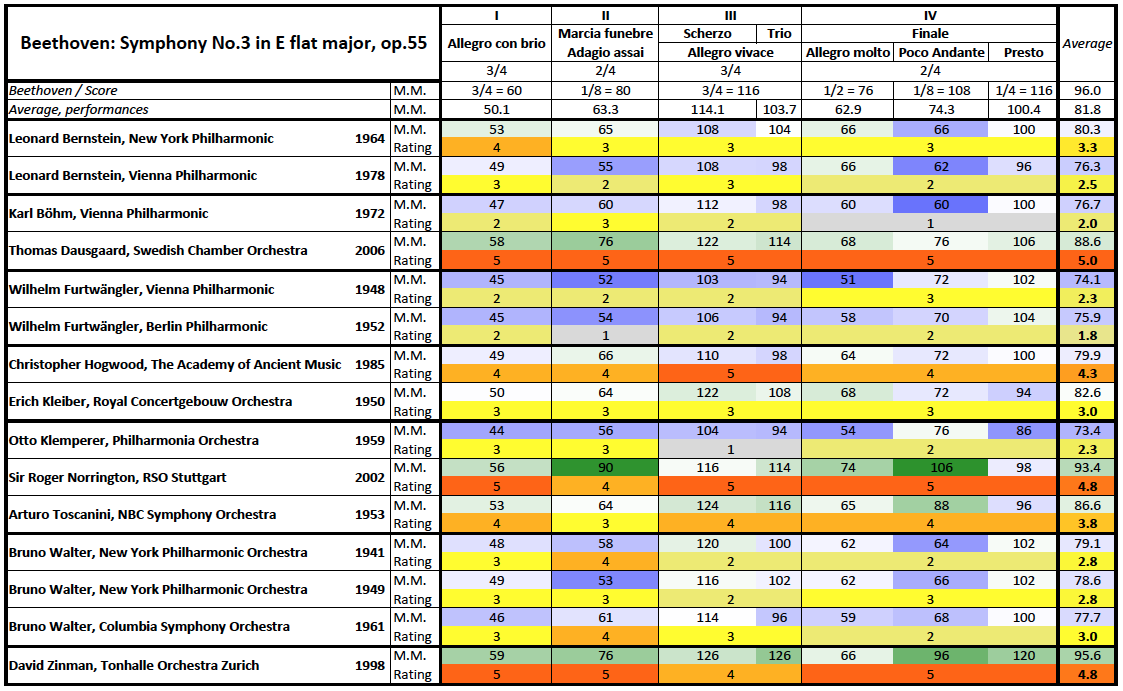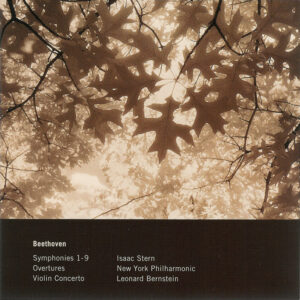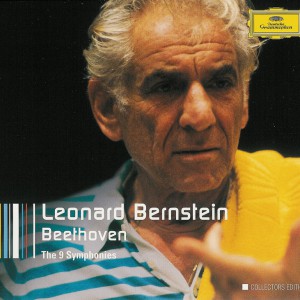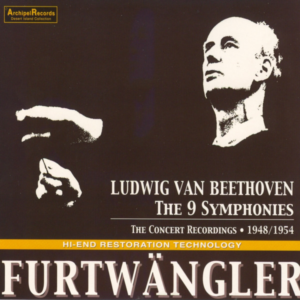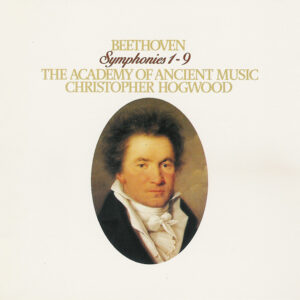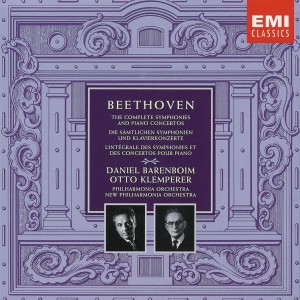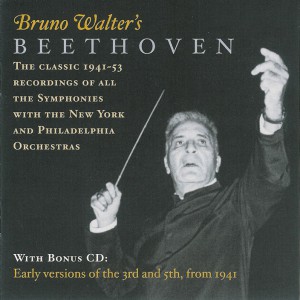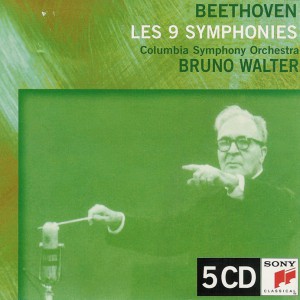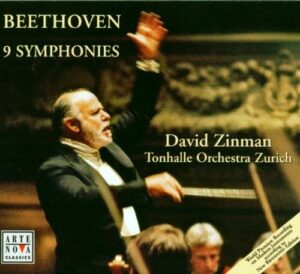Ludwig van Beethoven
Symphony No.3 in E♭ major, op.55, “Eroica”
Media Review / Comparison
2015-02-21 — Original posting
2015-08-20 — Added reference to Zinman’s complete symphony recording
2016-08-03 — Brushed up for better readability
Table of Contents
- Introduction / The Recordings
- Background, About the Composition
- The Movements
- The Interpretations, Overview
- The Interpretations, Detail
- Leonard Bernstein , New York Philharmonic Orchestra (1964)
- Leonard Bernstein , Vienna Philharmonic (1978)
- Karl Böhm , Vienna Philharmonic (1972)
- Thomas Dausgaard , Swedish Chamber Orchestra Örebro (2006)
- Wilhelm Furtwängler , Vienna Philharmonic (1948)
- Wilhelm Furtwängler , Berlin Philharmonic (1952)
- Christopher Hogwood , The Academy of Ancient Music (1985)
- Erich Kleiber , Royal Concertgebouw Orchestra (1950)
- Otto Klemperer , Philharmonia Orchestra (1959)
- Sir Roger Norrington , Radio-Sinfonieorchester Stuttgart (2002)
- Arturo Toscanini , NBC Symphony Orchestra (1953)
- Bruno Walter , New York Philharmonic Orchestra (1941)
- Bruno Walter , New York Philharmonic Orchestra (1949)
- Bruno Walter , Columbia Symphony Orchestra (1961)
- David Zinman , Tonhalle Orchestra Zurich (1998)
- Addendum
Introduction / The Recordings
This posting is about Ludwig van Beethoven’s Symphony No.3 in E♭ major, op.55, “Eroica”, of which I currently have 15 recordings — in chronological order:
- Bruno Walter, New York Philharmonic Orchestra (1941)
- Wilhelm Furtwängler, Vienna Philharmonic (1948)
- Bruno Walter, New York Philharmonic Orchestra (1949)
- Erich Kleiber, Royal Concertgebouw Orchestra (1950)
- Wilhelm Furtwängler, Berlin Philharmonic (1952)
- Arturo Toscanini, NBC Symphony Orchestra (1953)
- Otto Klemperer, Philharmonia Orchestra (1959)
- Bruno Walter, Columbia Symphony Orchestra (1961)
- Leonard Bernstein, New York Philharmonic Orchestra (1964)
- Karl Böhm, Vienna Philharmonic (1972)
- Leonard Bernstein, Vienna Philharmonic (1978)
- Christopher Hogwood, The Academy of Ancient Music (1985)
- David Zinman, Tonhalle Orchestra Zurich (1998)
- Sir Roger Norrington, Radio-Sinfonieorchester Stuttgart (2002)
- Thomas Dausgaard, Swedish Chamber Orchestra Örebro (2006)
Most of the older recordings — up to and including Bernstein with the Vienna Philharmonics — I are also have in my LP collection. I added the last four more recently, in order also to have current interpretations for comparison.
In the discussion below, I deal with the recordings in alphabetic order. My listening sequence is neither alphabetic nor chronological.
Background, About the Composition
Ludwig van Beethoven (1770 – 1827) wrote his Symphony No.3 in E♭ major, op.55, in 1804/05. The symphony follows the typical, classic scheme with four movements — but apart from that, it was meant to break with will all traditions in terms of symphony, i.e., it was written to sound like nothing people had ever heard back then. And it reflects the turmoil in Beethoven’s “inner life” in those years. I’m not including score samples, and my comments on the movements below are rudimentary, as a lot of material on this composition can be found elsewhere, e.g., in Wikipedia.
The range of interpretations in this comparison reflects the changes in interpretation style over the 20th century, starting off in a romantic / subjective tradition that had built up over the second half of the 19th century, and ending in what is now called “historically informed playing” (HIP). There are several aspects to this evolution:
Tempo
Beethoven has added metronome marks to all of his symphonies. Compared to “traditional” performances, these (often or mostly) simply appear unreasonably fast — people often commented that Beethoven’s metronome was simply broken. Newer research, however, revealed that — with a few, obvious errors — those metronome numbers can in fact be played, and they indeed make sense!
Rubato
Beethoven was very detailed in his notation, and it is unlikely that he assumed major additional tempo variations (accelerando, etc.) to be applied, beyond what is marked in the score.
Vibrato
The tradition of using ubiquitous vibrato has evolved only in the early 20th century; before that, vibrato was used occasionally only, e.g., to highlight specific notes, to let long notes in a slow movement evolve, etc. — like an ornament.
Orchestra Size and Arrangement
Orchestras in Beethoven’s time were much smaller than a typical, romantic symphony orchestra, and the violins were placed on either side of the podium (apparently throughout the 19th century), allowing for left-right dialogs to be heard. “Modern” orchestras often place both violin voices on the left side, which helps the coordination in virtuosic pieces, but is not what the classical composers had in mind.
Repeats
Some conductors may have considered repeats unnecessary; more importantly, early recording media were limited in the maximum duration of a “track”, so we can’t always blame the conductor for skipping repeats. In general, I think that Beethoven did not write repeat signs just out of some convention, but because that’s how he pictured his music — so, at least from the “middle period” on I think repeat signs ought to be followed.
Instruments
Quite often, using period instruments (along with HIP playing, such as little vibrato, light articulation, etc., and small orchestra sizes) reveals totally new aspects of a composition, new transparency, additional colors, better acoustic balance, etc., making one re-discover these compositions — it feels like digging out archeological artifacts from layers of (romantic) traditions.
That said — historic / legacy performances still have their value: at the very least they tell us about the recent history in interpretation of classical music.
The Movements
I. Allegro con brio, 3/4
M.M. annotation: 3/4 = 60, size 691 bars
Already in the first movement, Beethoven’s metronome mark of 1 bar (3/4) per second is clearly faster than most or all traditional performances.
II. Marcia funebre. Adagio assai, 2/4
M.M. annotation: 1/8 = 80, size 247 bars
This is not “just a funeral music”, but a funeral march — as it may have been used around 1800: music imitating a marching band — marching at a fairly fast pace. It’s definitely not the slow mourning music, but a relentless march towards the tomb.
III. Scherzo: Allegro vivace — Trio, 3/4
M.M. annotation: 3/4 = 116, size 442 bars
Interestingly, the perception of a Scherzo movement has apparently changed far less than that of a “funeral march” (or of the first movement in this symphony), so even historic performances are fairly close to Beethoven’s metronome markings. The Scherzo is repeated (except for the first 30 bars), the Trio consists of two parts (32 + 62 bars), the second part with repeat signs, and the movement ends with a second instance of the Scherzo, 186 bars, featuring four bars (381 – 384) in alla breve notation and a 20-bar Coda.
IV. Finale; Allegro molto, 2/4 — Poco Andante — Presto
M.M. annotation / size: 1/2 = 76, 347 bars (Allegro molto) — 1/8 = 108, 82 bars (Poco Andante) — 1/4 = 116, 43 bars (Presto)
This is a rather multi-faceted movement: basically a set of variations on a theme that Beethoven used in several earlier compositions, such as the Contretanz (counter dance) No.7 (WoO 14), the finale to the ballet “The Creatures of Prometheus”, op.43, and the so-called “Eroica variations” for piano, op.35. Here, however, the composer first just introduces the bass voice of the theme, then places it in two repeated, polyphonic sections for 3 and 4 voices, and then the movement gradually evolves into a polyphonic marvel, with fugue and a fugue on the inverted theme. That first part of the movement is Allegro molto, with a rather demanding metronome annotation.
A fermata in bar 348 leads into a 82 bar-section annotated Poco Andante (1/8 = 108). Based on the interpretations in this comparison I conclude that most (traditional) conductors took Poco Andante in its “absolute” meaning, interpreting the “walking a little” from the slow side, i.e., slower than Andante. However, the metronome annotation (to me) clearly indicates that Beethoven had something different in mind: a little slower than the Allegro, a little bit towards an Andante, i.e., the “poco” is to be taken from the fast side, which completely alters the character of this section.
The Interpretations, Overview
In order to provide a rating overview, as well as an idea about tempo relations both within an interpretation, as well as between the two recordings, I have prepared the little table below. Note that the color coding for the tempo (blue = slower, green = faster) refers to the average between the recordings, not to the metronome markings in the score (as the latter would have made just about everybody look slow!):The ratings should be clear (1 = lowest/gray, 3 = yellow, 5 = highest/orange) — these are meant to be my personal opinion and relative, not absolute.
The Interpretations, Detail
As mentioned above, I’m discussing the interpretations in alphabetic order (by the conductor’s last name) — note, however, that this is not the order in which I did the comparison: in the listening order, I try grouping similar recordings together, also typically listening to slower performances prior to faster ones, as I feel that this is the best way to do justice to every recording. Keep in mind that even if I make lots of critical comments to a given recording, this does not imply that I didn’t enjoy the music — even though I can’t deny that I’m in favor of historically informed performances: many of the older recordings definitely retain their historic value, and most of them are still interesting to listen to!
Leonard Bernstein, New York Philharmonic Orchestra (1964)
Beethoven: Symphonies 1 – 9, Overtures, Violin Concerto
Leonard Bernstein, New York Philharmonic Orchestra
Isaac Stern
Sony Classical SB6K 87885 (6 CDs, stereo); ℗ 1959 – 1970 / © 2002
Booklet: track listing only

This is from the earlier cycle of stereo recordings of all Beethoven symphonies that Leonard Bernstein (1918 – 1990) made with the New York Philharmonic Orchestra. Symphony No.3 was recorded in 1964.
Orchestra arrangement: Vl 1 — Vl 2 — Vla — Vc
Notes on the Movements
I. Allegro con brio, 3/4
Duration: 16’56”
Pure Toscanini heritage, in many ways! The same “cannon-shot chords” at the start, the same, if not more drive, the same tempo, the Coda is enthusiastic and enthralling like Rossini’s overtures, Bernstein’s enthusiasm at its best! Sure, there are some dynamic inaccuracies (often, f is louder than ff), but who cares with this interpretation? It’s not meant to be HIP!
II. Marcia funebre. Adagio assai, 2/4
Duration: 15’18”
The tempo is much better than in the more recent recording below, but especially in the first part it is rather soft, legato, too broad, lacks the “march feeling” — an elegiac funeral music, but not a march.
III. Scherzo: Allegro vivace — Trio, 3/4
Duration: 6’04”
A rather moderate tempo — yet, coordination issues right at the beginning. Lacking some Scherzo character, but balanced orchestra sound, with proper attention to the accompanying voices in the Scherzo.
IV. Finale; Allegro molto, 2/4 — Poco Andante — Presto
Duration: 11’21”
The beginning is very fast; sometimes, the tempo is a bit pushed, the coordination in the orchestra marginal (e.g., with the semiquavers in the a 4 segment), the p / pp often on the strong side. The Poco Andante is clearly too calm, starting with a complete stand-still.
Overall Duration: 49’38“
Rating (see above for details): 3.3 — I prefer this over Bernstein’s 1978 interpretation below.
Leonard Bernstein, Vienna Philharmonic (1978)
Beethoven: Symphonies 1 – 9
Leonard Bernstein, Vienna Philharmonic
DG 474 924-2 (5 CDs, stereo); ℗ 1980/2004 / © 1981
Booklet: 24 pp. en/de/fr

This is the more recent complete recording of all Beethoven symphonies by Leonard Bernstein (1918 – 1990), this time with the Vienna Philharmonics. The symphony No.3 was recorded in 1978.
Orchestra arrangement: Vl 1 — Vl 2 — Vla — Vc
Notes on the Movements
I. Allegro con brio, 3/4
Duration: 17’42”
A good, conventional interpretation, not much more, I’m afraid: the tempo falls back to the ordinary (compared to the earlier recording); careful articulation, good tempo control and phrasing, but a lot of vibrato, especially in the violins.
II. Marcia funebre. Adagio assai, 2/4
Duration: 17’40”
An impressive climax, but too celebrated, too much vibrato in the strings, strange rhythmic imbalance with the acciaccaturas (too much emphasis on the small notes?), the final ritardando is exaggerated. Surely very heartfelt by the conductor — but somehow, this does not transpire through the CD, especially considering that it is far too slow.
III. Scherzo: Allegro vivace — Trio, 3/4
Duration: 6’13”
Better coordination than in the older recording above; but strangely heavy / soft in the ornaments; the articulation in general is rather soft in the Scherzo, but the Trio on the other hand is carefully articulated.
IV. Finale; Allegro molto, 2/4 — Poco Andante — Presto
Duration: 11’48”
The beginning almost feels like an explosion, thereafter, the tempo is much slower, but with fairly strong variations / rubato — too strong from my perspective, sometimes feeling pushed in the faster parts: I don’t really understand Bernstein’s tempo concept. The articulation is sometimes superficial, the transparency moderate, the coordination not always as good as one would hope. The Poco Andante starts very slow, but at least shows an impressive build-up (one of Bernstein’s strengths!).
Overall Duration: 53’22“
Rating (see above for details): 2.5 — Not an improvement over the older recording, in my opinion.
Karl Böhm, Vienna Philharmonic (1972)
Beethoven: Symphony No.3, “Eroica”; Overture to Fidelio, op.72b; Overture No.3 to “Leonore”, op.72a
Karl Böhm, Vienna Philharmonic
DG 427 194-2(CD, stereo); ℗ 1969 / 1972
Booklet: track listing only

Karl Böhm (1894 – 1981) recorded the Symphony No.3 in 1972, as part of a complete cycle, with the Vienna Philharmonic Orchestra — for more information see the post “Beethoven: Symphony No.4 in B♭, op.60“.
Orchestra arrangement: Vl 1 — Vla — Vc — Vl 2
Notes on the Movements
I. Allegro con brio, 3/4
Duration: 14’58”, no repeats
To me, Böhm’s interpretation — as slow as other traditional recordings — lacks dynamic differentiation and contrast: there’s very little real p playing. This way, the piece — a fairly long movement anyway, at least for the time when it was composed — is too uniform, the music lacks life, vitality.
II. Marcia funebre. Adagio assai, 2/4
Duration: 16’18”
Played well by the orchestra, good sound (recording & orchestra), but the interpretation is rather uniform, static, sometimes close to boring, fairly legato, sometimes just loud; the big phrases are there, but differentiation is missing in the details. Occasional intonation impurities (timpani close to the end!). The basses in the beginning remind me of a snoring old man — doesn’t that say it all? It’s not a march, for sure.
III. Scherzo: Allegro vivace — Trio, 3/4
Duration: 6’03”
This feels relaxed, rather a Menuetto than a Scherzo; the Trio is rather clumsy, slow.
IV. Finale; Allegro molto, 2/4 — Poco Andante — Presto
Duration: 12’30”
Not feeling like Allegro, sounding unstructured in general, p and pp (e.g., the pizzicati in the introduction of the bass voice of the theme) are too loud. The Allegro molto part often sounds harmless, sometimes also like late Mozart (even that was less harmless, though!). I also find the interpretation superficial in details, lacking agogics and differentiation. Böhm uses an accelerando (why?) up to the Poco Andante part, which then feels extremely slow, static, and not related to the rest of the movement.
Overall Duration: 49’48“
Rating (see above for details): 2.0 — I can’t recommend this.
Thomas Dausgaard, Swedish Chamber Orchestra Örebro (2006)
Beethoven: Symphony No.3 in E♭ major, op.55; Violin Romances opp.40 & 50; 12 Contredances; Funeral March from “Leonore Prohaska”
Thomas Dausgaard, Swedish Chamber Orchestra Örebro
Katarina Andreasson, violin
Simax classics/ iTunes download (CD, stereo, 256 kbps); ℗ 2006
Booklet: none

Since 1997, Thomas Dausgaard (*1963) is the principal conductor of the Swedish Chamber Orchestra in Örebro. For more information see the post “Beethoven: Symphony No.4 in B♭, op.60“. This symphony was recorded in 2006.
Orchestra arrangement Vl 1 — Vla — Vc — Vl 2
Notes on the Movements
I. Allegro con brio, 3/4
Duration: 15’47”
Very close to Beethoven’s metronome mark, very close to Zinman’s tempo, but with a smaller orchestra in historically correct arrangement (as in Norrington’s recording), virtually no vibrato, i.e., clearer intonation, light articulation, excellent transparency. I also think it’s more energetic than Zinman’s interpretation, more lively, with more agogics. For me, this is the best interpretation of this movement in the comparison.
II. Marcia funebre. Adagio assai, 2/4
Duration: 12’50”
Very good! Excellent tempo, articulation, tone / sound, phrasing, dynamics — I really like this version!
III. Scherzo: Allegro vivace — Trio, 3/4
Duration: 5’23”
On a par with Norrington: Fast, but not rushed, with excellent control (ornaments!) and coordination, also with excellent, detailed articulation, alert, with tension, really pp where the score asks for it! Very little slowdown in the Trio.
IV. Finale; Allegro molto, 2/4 — Poco Andante — Presto
Duration: 10’28”
The start feels very fast — but the tempo is consequent and reasonably close to Beethoven’s annotation; occasionally, it feels slightly pushed — Dausgaard rates drive above technical perfection. What I really like about this interpretation above most others is that the entire Allegro molto part (i.e., the initial cascade, the presentation of the theme’s bass, the a 3 and a 4 segments, the fugato variations, etc.) all form a logical, musical unity. Also, I really like how Dausgaard does not interpret every fermata as the end point of a ritardando: I checked the score, and there are several fermatas, but there isn’t a single instance of a ritardando (nor accelerando) in this movement.
Overall Duration: 44’25“
Rating (see above for details): 5.0 — This may not be technically perfect everywhere, but it still is my favorite recording, overall.
Wilhelm Furtwängler, Vienna Philharmonic (1948)
Beethoven: Symphonies 1 – 9
Wilhelm Furtwängler, Vienna Philharmonic
Berlin Philharmonic, Philharmonia Orchestra, SDR Symphony Orchestra
live recordings 1948 – 1954
IMD Music Distribution Ltd. ARPCD 0214 (5 CDs, mono); ℗ / © 2004
Booklet: track listing only

This is from a collection of live concert recordings that Wilhelm Furtwängler (1886 – 1954) made 1948 – 1954, with various orchestras; the collection includes two recording of op.55: the one with the Vienna Philharmonic Orchestra was recorded in 1948.
Notes on the Movements
I. Allegro con brio, 3/4
Duration: 16’10”, no repeats
My remarks about the 1952 recording with the Berlin Philharmonics (see below) essentially apply here as well; there are moments where I felt a lack of tempo control: I’m not sure whether that’s the — deliberately — unclear conducting or just another aspect of Furtwängler’s rubato — the tempo variations are even more extreme than in the more recent recording below, often severely disrupting the flow. With all the evolution, the knowledge that was acquired in the years since this recording, it is fairly hard to enjoy this recording (or the one from 1952).
II. Marcia funebre. Adagio assai, 2/4
Duration: 17’21”
Very slow (though not as extreme as the 1952 recording below), melodies very legato, played as 4/8.
III. Scherzo: Allegro vivace — Trio, 3/4
Duration: 6’37”
As in the 1952 recording, the movement is lacking wit, Scherzo character — it is even somewhat slower, heavy, if not sometimes gross, though the tempo is more consequent / persistent than in the newer recording.
IV. Finale; Allegro molto, 2/4 — Poco Andante — Presto
Duration: 12’16”
The beginning is less impulsive than Furtwängler’s 1952 interpretation, and thereafter, the base tempo is extremely slow, but featuring some rather extreme accelerandi / rubato (e.g., already in the a 3 / a 4 sections); from today’s perspective, the tempo often seems arbitrary, in the slow extremes feeling like a quiet dance movement. This is a live recording, which may explain some of the occasional coordination issues. In this earlier recording, there is no pause between the first part and the Poco Andante — the base tempo in that part is rather slow, but at least, the music has tension and some outlook / forward perspective (and build-ups with a fairly strong accelerando).
Overall Duration: 52’22“
Rating (see above for details): 2.3 — It’s interesting to see the difference between two Furtwängler interpretations only four years apart!
Wilhelm Furtwängler, Berlin Philharmonic (1952)
Beethoven: Symphonies 1 – 9
Wilhelm Furtwängler, Berlin Philharmonic
Vienna Philharmonic, Philharmonia Orchestra, SDR Symphony Orchestra
live recordings 1948 – 1954
IMD Music Distribution Ltd. ARPCD 0214 (5 CDs, mono); ℗ / © 2004
Booklet: track listing only

This is from a collection of live concert recordings that Wilhelm Furtwängler (1886 – 1954) made 1948 – 1954, with various orchestras; the collection includes two recording of op.55: the one with the Berlin Philharmonic Orchestra was recorded in 1952.
Notes on the Movements
I. Allegro con brio, 3/4
Duration: 16’16”, no repeats
The one striking feature in this recording is Furtwängler’s extreme rubato: he often broadens the tempo, then — often in ff or crescendo parts — he accelerates again, in a way that sometimes sounds or feels like the start of a steam engine or an accelerating train / steam locomotive. The basic tempo is rather heavy, certainly not Allegro, let alone con brio. The articulation is moderately accurate, the coordination is not perfect (Furtwängler’s conducting style was notoriously confusing), the dynamics are fairly free (sfp is often just sf), sometimes overblown.
II. Marcia funebre. Adagio assai, 2/4
Duration: 18’48”
Extremely slow, heavy, overblown, maybe describing an extreme tragedy, chords like erratic blocks; I’m sure this was sincerely felt by the conductor, and likely also the audience — but with the preserved audio only, this at best reminds me of the music to Siegfried’s death; it is definitely not a march, not even read as 4/8. And the end is even slower…
III. Scherzo: Allegro vivace — Trio, 3/4
Duration: 6’28”
The tempo is somewhat slow, the articulation heavy, slightly overblown; I feel a tendency to play faster when louder. Also, the movement is lacking its witty Scherzo character.
IV. Finale; Allegro molto, 2/4 — Poco Andante — Presto
Duration: 12’41”
The start of the movement is wild, uncontrolled like a torrent. The “Eroica” theme then starts very quiet, static — until in the “a 3” and “a 4” sections Furtwängler makes an extreme accelerando: the rubato here is clearly a sign of Zeitgeist. Mostly, Furtwängler’s tempo is more fluent than Klemperer’s, and there are less dynamic contrasts — instead, there are these extreme rubati which occasionally also causes coordination issues.
At the transition to the Poco Andante, Furtwängler inserts a very long pause of about 7 seconds (the score has a fermata, but no rest at all); the Presto ending is as wild and eruptive as the beginning of the movement. Furtwängler has a clear, strong concept here — it’s just so far from any of the recent interpretations that it’s hardly imaginable. The long pause prior to the Poco Andante to me indicates that Furtwängler was making such decisions on the spot, reacting to the “spirit of the event”.
Overall Duration: 54’12“
Rating (see above for details): 1.8 — Certainly a very valuable historic document — and it should be heard as such.
Christopher Hogwood, The Academy of Ancient Music (1985)
Beethoven: Symphonies 1 – 9, Overtures to “Coriolan” and “Egmont”
Christopher Hogwood, The Academy of Ancient Music
Decca / L’Oiseau-Lyre 425 z696-2 (6 CDs, stereo); ℗ 1986 – 89 / © 1989
Booklet: 90 pp. en/fr/de/it

Christopher Hogwood (1941 – 2014) made this recording of all Beethoven symphonies with the Academy of Ancient Music between 1983 and 1989 — Symphony No.3 was recorded in 1985. For more information see the post “Beethoven: Symphony No.4 in B♭, op.60“.
Orchestra arrangement: Vl 1 — Vla — Vc — Vl 2
Notes on the Movements
I. Allegro con brio, 3/4
Duration: 17’51”
Clearly a different “kind of beast” compared to traditional (non-HIP) performances: very nice, colorful, “historic” instrument sound, careful and detailed articulation, light instrumentation, transparent sound — maybe sometimes a bit too soft & lovely (occasionally reminds me of the Pastoral symphony), but accurate in dynamics etc.; unfortunately, the point this does not follow is the basic tempo (too slow, not really Allegro con brio, let alone close to Beethoven’s metronome mark). Also, in the development period, around bar 284ff., the tempo picks up in a way that feels like loss of tempo control — strange. The proper historic orchestral arrangement (opposing violins) for sure helps the transparency and the acoustic balance.
II. Marcia funebre. Adagio assai, 2/4
Duration: 15’00”
Very close to Toscanini in the tempo, still too slow, though; good articulation; initially the sound of the orchestra is somewhat muted.
III. Scherzo: Allegro vivace — Trio, 3/4
Duration: 6’07”
Transparent, carefully articulated — excellent (period instrument) sound, a joy to listen, especially with the wind instruments! Maybe a tad slow, overall.
IV. Finale; Allegro molto, 2/4 — Poco Andante — Presto
Duration: 11’07”
Compared to other recordings, the sound may initially appear slightly thin — but one quickly adapts to the tone of this recording; the tempo is considerably below Beethoven’s annotation — but then, one can enjoy the left-right dialogs between the two violin voices, the absence of the vast tempo variations in older recordings in favor of decent agogics. The transparency can’t always quite compete with newer recordings — but this is likely a question of the sound management during the recording.
Overall Duration: 50’03“
Rating (see above for details): 4.3 — A very good, early / pioneering historically informed interpretation with a warm, well-rounded sound; the one drawback against newer recordings is in the traditional / moderate tempo selection.
Erich Kleiber, Royal Concertgebouw Orchestra (1950)
Beethoven: Symphonies 3 & 5
Erich Kleiber, Royal Concertgebouw Orchestra
Decca Legends 467 125-2 (CD, mono); ℗ 1951, 1953 / © 2000
Booklet: 20 pp. en/fr/de

Erich Kleiber (1890 – 1956) was mainly known as an opera conductor, but he did leave behind some fine orchestral recordings, too, such as this one with two Beethoven symphonies, which were recorded in May 1950 (Symphony No.3) and in September 1953 (Symphony No.5).
Notes on the Movements
I. Allegro con brio, 3/4
Duration: 14’05”, no repeats
A dramatic interpretation that ignores potential and factual losses on its path: there are problems with the coordination and the tempo stability in the orchestra. Like Walter, Erich Kleiber slows down for the secondary theme, he uses a fair amount of rubato in the development section, which probably contributed to the coordination issues. From a recording point-of-view, the woodwind instruments (particularly clarinets and oboes) sound pretty awful, which for sure is not the fault of the artists.
II. Marcia funebre. Adagio assai, 2/4
Duration: 15’27”
More legato than Bruno Walter, and unfortunately lacking the march(ing) feeling. I don’t quite understand the agogics here — the tempo occasionally feels somewhat undetermined.
III. Scherzo: Allegro vivace — Trio, 3/4
Duration: 5’33”
Fairly limited sound (recording); fairly fast — the tempo is at the limit for the orchestra, causing occasional coordination problems. But the interpretation as such is fairly convincing.
IV. Finale; Allegro molto, 2/4 — Poco Andante — Presto
Duration: 11’15”
In the Allegro molto part, this is among the fastest interpretations — it is very resolute, consistently fast, has drive — and Kleiber doesn’t do those excessive ritardandi that we hear in other interpretations of that time; Kleiber keeps the tempo despite some occasional rhythmic synchronization / coordination issues. The sound of the recording is somewhat brassy, limited, especially with the wind instruments (but this was 65 years ago, after all).
Overall Duration: 46’18“
Rating (see above for details): 3.0 — To me, one of the most interesting & remarkable interpretations among the historic recordings.
Otto Klemperer, Philharmonia Orchestra (1959)
Beethoven: The Complete Symphonies and Piano Concertos; Choral Fantasia; Great Fugue op.133; Overtures Leonore 1-3, Coriolan, Prometheus
Otto Klemperer, Philharmonia Orchestra, Daniel Barenboim
EMI 5 73895 2 (9 CDs, stereo); ℗ / © 2000

This is part of the complete cycle of Beethoven symphonies (later also including the piano concertos, with Daniel Barenboim and the New Philharmonia Orchestra) that Otto Klemperer (1885 – 1973) realized in the late fifties, with the Philharmonia Orchestra; Symphony No.3 was recorded in 1959. For more information see the post “Beethoven: Symphony No.4 in B♭, op.60“.
Orchestra arrangement: Vl 1 — Vla — Vc — Vl 2
Notes on the Movements
I. Allegro con brio, 3/4
Duration: 16’41”, no repeats
A typical, traditional interpretation — not really Allegro con brio, and the second theme (bars 84ff.) is rather heavy, static, the Coda is taken slightly broader. But overall, one can feel that the conductor has a clear concept, the orchestra sound is reasonably transparent.
II. Marcia funebre. Adagio assai, 2/4
Duration: 16’54”
Slow, as all traditional performances, but not as overblown as Furtwängler, consequent, with a clear concept, expressive.
III. Scherzo: Allegro vivace — Trio, 3/4
Duration: 6’34”
The one positive thing about this interpretation is that it profits from the historically correct string placement, with opposing violin voices; but apart from that, the interpretation doesn’t resemble a Scherzo: it is too slow — and yet, the recording suffers from coordination issues, despite the moderate tempo. True, the opposing violin voices are more demanding for the coordination — but for a studio recording…
IV. Finale; Allegro molto, 2/4 — Poco Andante — Presto
Duration: 13’26”
Klemperer (himself a composer) obviously wants to point out the “modernist” aspects in this movement, placing it near the “Great Fugue”, op.133. He exerts firm tempo control — and the tempo is on the heavy side, definitely not an Allegro molto. In the “a 3” and “a 4” sections, he has only a small string ensemble playing — a nice idea, though it makes the subsequent section appear almost forceful. It’s nice to see the left-right dialogs between the two violin voices. Apart from some very minor coordination issues (a likely drawback of the historic orchestra arrangement), it’s played quite well and carefully — I only wish the Allegro molto (i.e., very joyful) came through a bit more.
The Poco Andante is not as slow as one might expect from the “fast” tempi in this movement, but it still falls short of Beethoven’s annotation. One little hiccup: in bar 418 (the last ff in the Poco A, prior to the final Presto), there is a cutting error, the second semiquaver (approx.) is missing. When listening superficially, this is hardly noticeable, though.
Overall Duration: 53’35“
Rating (see above for details): 2.3 — A solid, but very traditional / interpretation.
Sir Roger Norrington, Radio-Sinfonieorchester Stuttgart (2002)
Beethoven: Symphonies 1 – 9, Introductions by Sir Roger Norrington
Sir Roger Norrington, Radio-Sinfonieorchester Stuttgart
Hänssler Classics (5 CDs + Bonus CD, stereo); ℗ 2000 / © 2000
Booklet: 17 pp. de/en (this CD)

Sir Roger Norrington (*1934) recorded Symphony No.3 with the Radio-Sinfonieorchester Stuttgart in 2002, from live concerts. For more information see the post “Beethoven: Symphony No.4 in B♭, op.60“.
Orchestra arrangement: Vl 1 — Vla — Vc — Vl 2
Notes on the Movements
I. Allegro con brio, 3/4
Duration: 15’47”
Excellent: one of only three recordings with the “right” tempo, i.e., truly Allegro con brio, and close to Beethoven’s (ambitious) metronome mark! It’s not HIP in that the orchestra is playing modern instruments, but at least, the string instruments play without vibrato, and the timpani play with wooden (hard) drum sticks, the orchestra is (relatively) small & transparent, and uses the historically correct string arrangement. As stated, Beethoven’s tempo annotation is ambitious — in this orchestra at least, the first half of the movement sometimes feels a bit pushed, and there are occasional coordination issues within the orchestra — but this may also be due to the live concert recording, nervousness in the orchestra, etc.; at least, the interpretation never really loses drive!
II. Marcia funebre. Adagio assai, 2/4
Duration: 12’18”
Norrington is very firm in general about following Beethoven’s metronome marks — here, however, he is definitely too fast (1/8 = 90 rather than 1/8 = 80), leaving a movement with noticeable unrest: it’s meant to be a (relatively) fast, relentless march, but not the Bersaglieri (a well-known tradition of Italian military band that is literally running while playing, rather than marching)!
III. Scherzo: Allegro vivace — Trio, 3/4
Duration: 5’46”
Transparent, excellent tempo, most detailed dynamics and phrasing/articulation — very good, indeed! Very nice, bright & brilliant horn sound in the Trio!
IV. Finale; Allegro molto, 2/4 — Poco Andante — Presto
Duration: 9’57”
This is the only interpretation that matches Beethoven’s metronome mark in the Allegro molto part — though the orchestra is operating at its technical limits. Norrington is very detailed and careful about Beethoven’s articulation and dynamic annotations. Norrington is relentless in the tempo, even gradually accelerates in the fugato parts — dramatic, occasionally at the limit of being pushed, to the point where the articulation starts to become slightly superficial (but this is a live recording). Also in the Poco Andante, Norrington is exactly at Beethoven’s metronome value — and amazingly, this doesn’t really feel rushed (except in comparison with others, maybe compared with the listener’s expectations), it appears logical and does not disrupt the movement as in traditional interpretations, but forms a bridge between the Allegro molto and the final Presto.
Overall Duration: 44’44“ (incl. applause); in addition: extra track with Norrington’s introduction (9’42”)
Rating (see above for details): 4.8 — Among my top favorites, for sure! The second movement may be a bit overdone, the orchestra not always quite perfect, but the result is nevertheless convincing!
Arturo Toscanini, NBC Symphony Orchestra (1953)
Beethoven: Symphonies 1 – 9
Arturo Toscanini, NBC Symphony Orchestra
(recorded 1951 – 53)
RCA / BMG Classics 828786-55702-2 (5 CDs, mono); ℗ / © 2003
Booklet: 63 pp. en/de/fr

In 1949 – 1953, Arturo Toscanini (1867 – 1957) performed all Beethoven symphonies with the NBC Symphony Orchestra, at Carnegie Hall, mostly for direct radio broadcasts; it’s his last performance of the complete cycle, a key part of Toscanini’s legacy. The Symphony No.3 was recorded live and broadcast on 1953-12-06.
Notes on the Movements
I. Allegro con brio, 3/4
Duration: 14’13”, no repeats
Of all the historic recordings in this comparison, this is the most modern-sounding (closest to HIP) one, for sure! Toscanini not only is amazingly close to Beethoven’s metronome rate — his interpretation is the most stringent one, with incredible drive (particularly considering the traditional recordings of that same time)! The initial staccato chords are as sharp and loud as cannon shots! Yes, like Bruno Walter he does also slow down for the secondary theme a bit (at least twice) — but that’s merely transitional, just to pick up tempo again. Well done!
II. Marcia funebre. Adagio assai, 2/4
Duration: 15’26”
Fairly consequent in the tempo, the music can be seen as slow march (Beethoven’s tempo probably appeared impossible back then!); resolute, determined, especially in the middle part. Occasionally, the vibrato (especially with the oboes and the flute) is a bit nervous (Zeitgeist?).
III. Scherzo: Allegro vivace — Trio, 3/4
Duration: 5’27”
Toscanini’s tempo is astounding, faster than specified in the score — and the orchestra discipline is equally amazing, especially considering it is a live recording! Sure, it is a big orchestra, but the interpretation sounds modern, almost like HIP recordings, excellent!
IV. Finale; Allegro molto, 2/4 — Poco Andante — Presto
Duration: 11’21”
Very resolute in general — one feels Toscanini’s firm control. The conductor accelerates in the a 3 part, and the a 4 section is distinctly faster. Inevitably, there are Toscanini’s stringendo build-ups, and there is a general, gradual accelerando over the fugato parts in the Allegro molto section. In the Poco Andante, Toscanini is by far the fastest among the traditional and historic interpretations — a clear sign that he was checking the sources, taking Beethoven’s annotations for real!
Overall Duration: 46’25“
Rating (see above for details): 3.8 — My favorite among the traditional and historic interpretations!
Bruno Walter, New York Philharmonic Orchestra (1941)
Beethoven: Symphonies 1 – 9
Bruno Walter, New York Philharmonic Orchestra
(recorded 1941 – 53)
Music & Arts CD-1137 (6 CDs, mono); ℗ 2004
Booklet: 12 pp. English

This is part of Bruno Walter‘s (1876 – 1962) well-known mono recording cycle with the New York Philharmonic Orchestra, realized between 1946 and 1952 (Symphony No.8: 1942, the CD release also includes early recordings from symphonies No.3 and 5 from 1941). The first recording of Symphony No.3 was recorded on 1941.
Notes on the Movements
I. Allegro con brio, 3/4
Duration: 15’00”, no repeats
Sure, the sound is limited — but to me, this is the most modern-sounding of Bruno Walter’s interpretations; it is faster than the 1961 interpretation, definitely with a better tempo, clearer in dynamics and articulation (although the dynamics of the recording are limited). One characteristic trait of Walter’s interpretation is that the secondary theme is taken somewhat slower (e.g., bars 22 – 34, 57ff., 84 – 98, 284 – 298, 322 – 337, 486 – 501, and 581 – 595), which to me disrupts the flow, makes the piece lose drive, flow.
II. Marcia funebre. Adagio assai, 2/4
Duration: 16’22”
Very expressive, lots of rubato, heavy, “outspoken grief”, almost forceful, screaming out pain around the climax, but solemn overall, and impressive; I prefer this over the 1949 interpretation below.
III. Scherzo: Allegro vivace — Trio, 3/4
Duration: 4’35”, Scherzo repeat not done
This is the fastest among Bruno Walter’s Scherzo interpretations — unfortunately suffering from coordination issues. In the Trio, Bruno Walter uses an extreme rubato, varying the tempo between 85 and 110 (estimated): unusual for today’s ears, to say the least.
IV. Finale; Allegro molto, 2/4 — Poco Andante — Presto
Duration: 12’10”
Careful articulation, but the tempo is not Allegro. Walter accelerates in the a 3 / a 4 sections; in the latter, the semiquavers lack precision — the coordination in the orchestra is not perfect in general, and so is the articulation. From today’s perspective, the glissandi / portamenti in the strings may appear a bit strong at times. Walter uses fairly strong accelerandi in his build-ups (e.g., in the last part of the Allegro molto, and in the Poco Andante) — but at least one can feel a strong concept in the interpretation.
Overall Duration: 48’06“
Rating (see above for details): 2.8 — In the second movement, I prefer this over the 1949 interpretation.
Bruno Walter, New York Philharmonic Orchestra (1949)
Beethoven: Symphonies 1 – 9
Bruno Walter, New York Philharmonic Orchestra
(recorded 1941 – 53)
Music & Arts CD-1137 (6 CDs, mono); ℗ 2004
Booklet: 12 pp. English

This is part of Bruno Walter‘s (1876 – 1962) well-known mono recording cycle with the New York Philharmonic Orchestra, realized between 1946 and 1952 (Symphony No.8: 1942, the CD release also includes early recordings from symphonies No.3 and 5 from 1941). The second recording of Symphony No.3 was done in 1949.
Notes on the Movements
I. Allegro con brio, 3/4
Duration: 14’49”, no repeats
Obviously clearer in sound than the earlier recording, but also more fluent as interpretation, softer, though, maybe a bit less consequent (more rubato, with a somewhat odd accelerando around bar 440); one downside of the recording is in coordination issues in the orchestra, especially in the development phase.
II. Marcia funebre. Adagio assai, 2/4
Duration: 16’35”
Slow, softer than Klemperer, dense, a lot of legato articulation, broad, sometimes a fair amount of vibrato (e.g., in the flute around bar 70); the end is pretty static.
III. Scherzo: Allegro vivace — Trio, 3/4
Duration: 4’38”, Scherzo repeat not done
Good tempo (exactly as specified in the score), but suffering from bad coordination in the orchestra and (strange for Bruno Walter!) superficial articulation — not convincing.
IV. Finale; Allegro molto, 2/4 — Poco Andante — Presto
Duration: 11’52”
Among Bruno Walter’s interpretations, this one has the clearest tempo concept — though some of it probably sounds rather strange today, e.g., the strong accelerando in the fugue parts. The Poco Andante part features a good build-up.
Overall Duration: 47’52“
Rating (see above for details): 2.8 — A valuable historic document — but quite far away from recent interpretations (let alone HIP).
Bruno Walter, Columbia Symphony Orchestra (1961)
Beethoven: Symphonies 1 – 9
Bruno Walter, Columbia Symphony Orchestra
(recorded 1958 – 61)
Sony Classical SMM5023122 (5 CDs, stereo); ℗ 1958 – 63, 1993 / © 2001
Booklet: none

With the availability of stereo recording technique, CBS wanted Bruno Walter (1876 – 1962) to re-record the Beethoven symphony cycle (realized 1958 – 1961) — and they even founded an orchestra for this purpose, the Columbia Symphony Orchestra. The Beethoven Symphony No.3 was recorded in 1961.
Orchestra arrangement: Vl 1 — Vl 2 — Vla — Vc
Notes on the Movements
I. Allegro con brio, 3/4
Duration: 16’06”, no repeats
When switching over from older recordings (such as Furtwängler’s), one feels somewhat overwhelmed by the bass — maybe the sound engineers wanted to demonstrate how “good” stereo sounds? For me, the bass is too strong — but that does not affect the interpretation. Bruno Walter is very careful, accurate and detailed in executing the composer’s dynamic annotations; the articulation is sometimes a bit broad, too tender / soft, e.g.: there are instances of staccato crotchets under a phrasing ligature — Walter has these — persistently — executed portato.
Occasionally, the interpretation appears to lose drive, e.g., in the development period — or maybe it’s just that Walter’s agogics (truly moderate compared to Furtwängler!) now feel somewhat strange? One example is the secondary theme, e.g., in bars 581 – 595 (and earlier, equivalent instances, see the 1941 interpretation above), which is played somewhat slower — this makes no sense to me.
II. Marcia funebre. Adagio assai, 2/4
Duration: 15’34”
Among Bruno Walter’s interpretations, this has the best tempo — one can see this as a slow funeral march (4/8, maybe), relentless, determined, the inevitability of death.
III. Scherzo: Allegro vivace — Trio, 3/4
Duration: 6’04”
The tempo in the Scherzo is OK, but there are problems with the coordination between strings and the wind instruments, and the tempo difference to the Trio is rather (too) big.
IV. Finale; Allegro molto, 2/4 — Poco Andante — Presto
Duration: 12’21”
The tempo is not really Allegro, but more or less OK, harmonic — sometimes somewhat heavy. Transparency and precision in the orchestra are just moderate. Walter accelerates in the Allegro molto part — which makes the slow Poco Andante feel even slower. Because of the slowness of the Poco Andante (presumably), Walter is accelerating also in that part.
Overall Duration: 50’05“
Rating (see above for details): 3.0 — The last movement is the weakest part in this interpretation.
David Zinman, Tonhalle Orchestra Zurich (1998)
Beethoven: Symphonies 3 & 4
David Zinman, Tonhalle Orchestra Zurich
Arte Nova 74321 59214 2 (CD, stereo); ℗ / © 1998
Booklet: 20 pp. de/en/fr

Beethoven: Symphonies 1 – 9
David Zinman, Tonhalle Orchestra Zurich
Arte Nova 74321 65410 2 (5 CDs, stereo); ℗ / © 1997-1999
Booklet: de/en/fr

David Zinman (*1936) has directed the Tonhalle Orchestra Zurich between 1995 and 2014. For more information see the post “Beethoven: Symphony No.4 in B♭, op.60“. Symphony No.3 was recorded in 1998.
Orchestra arrangement: Vl 1 — Vl 2 — Vla — Vc
Notes on the Movements
I. Allegro con brio, 3/4
Duration: 15’37”
A refreshing performance, faster than Norrington, almost at Beethoven’s (ambitious) metronome mark — yet, by and large relaxed playing (i.e., not appearing pushed); near-perfect, maybe too smooth? Possible (mostly minor) points of criticism are the relatively large orchestra with modern arrangement that defeats composed left-right dialog effects, and the use of vibrato (e.g., right in the first bars, in the violins) which affects the clarity of the intonation, of the music.
II. Marcia funebre. Adagio assai, 2/4
Duration: 12’59”
Excellent tempo, very close to what Beethoven specified, not adding extra pathos, with a number of additional ornaments in the oboe (almost typical of slow movements in Zinman’s interpretations!) — somewhat unusual, but still a nice idea. I like how the middle (maggiore) part is taken a bit faster, expressing hope, maybe, or good memories?
III. Scherzo: Allegro vivace — Trio, 3/4
Duration: 6’16”, second Scherzo part repeated as well
Obviously an attempt to be faster than others (the fastest Scherzo and Trio in this comparison) — too fast, indeed, suffering from some coordination issues, some superficialities, rushed ornaments, but also too smooth in articulation. Simply too fast, overdone, and at this tempo, the four Alla breve bars (381 – 384) lose most of their effect. Maybe it’s because of the very fast tempo that Zinman also repeats the second instance of the Scherzo (prior to the Coda)?
IV. Finale; Allegro molto, 2/4 — Poco Andante — Presto
Duration: 10’32”
Extremely virtuosic, near-perfect playing, very detailed in dynamics and articulation; the introduction of the theme’s bass with the pizzicati is really pp; the a 4 part is done with solo instruments — a good / nice idea! Another nice idea: the oboe takes the opportunity of the fermata at bar 95 to play a (very) short cadenza (typical for many of Zinman’s interpretations!). The entire interpretation is rhythmically meticulous; the Poco Andante may appear relatively fast (still below Beethoven’s metronome marks, though) — it is moving forward, but without noticeable unrest — and again, there are some extra, well-fitting ornaments in the oboe voice; I really enjoy this interpretation!
Overall Duration: 45’21“
Rating (see above for details): 4.8 — One of my favorite interpretations, even though it isn’t really HIP. Sometimes it’s a bit too polished / perfect, and the “non-historic” orchestra arrangement causes the listener to miss out on some aspects of Beethoven’s composition, especially in the polyphonic parts.
Addendum
I use an Eulenburg pocket score to follow this music while listening. —Find pocket score on amazon.com (#ad) —


